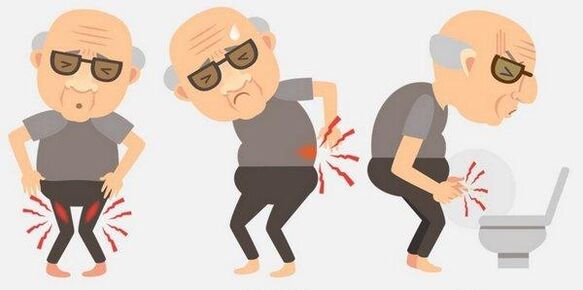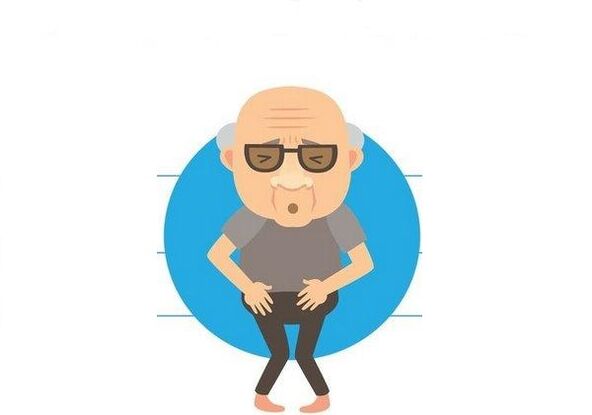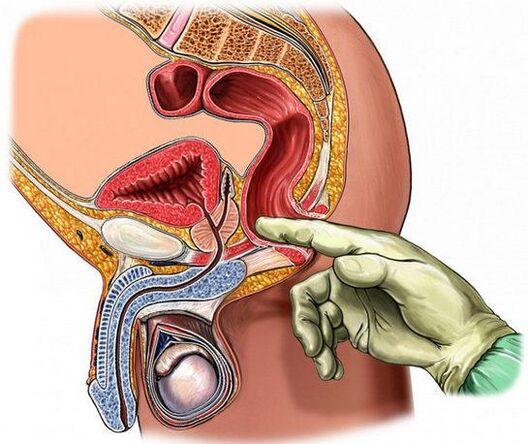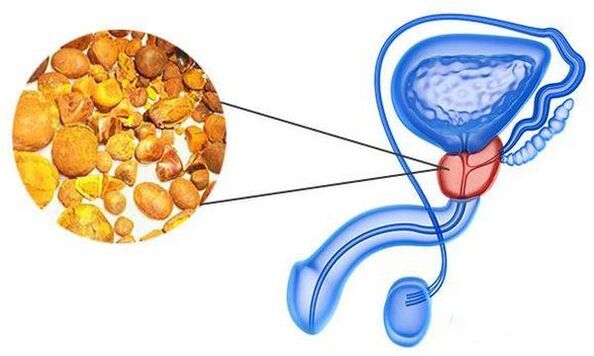Symptoms of prostatitis depend on the shape and causes of inflammation of the prostate gland, as well as on the presence of concomitant diseases. Symptoms often intersects, which significantly complicates the diagnosis.

Chronic prostatitis
Chronic prostatitis develops as an independent disease or as a complication of acute form of inflammation. During remission, symptoms are weak or completely absent, with exacerbation they become more pronounced. The clinical picture resembles acute prostatitis.
The first symptoms of the chronic form of inflammation:
- Frequent urge to urination;
- Stupid pains in the lower abdomen;
- Discomfort in the prostate area (area from testicles to anus) with a long stay in the sitting position. Subsequently, sitting for more than an hour is impossible due to burning;
- Intermittent, painful urination;
- Dull pain in the rectum during defecation;
- Deterioration of an erection, discomfort in the groin during ejaculation is possible.
The above signs in the chronic form of prostatitis are not manifested at once. Initially, this can be a lubricated orgasm, premature ejaculation, then a man has to strain during urination, pain gradually joins.
On an ultrasound with chronic inflammation, a decrease in the density of prostate tissues, an increased degree of reflection of the wave of fabric, is observed. In places, it decreases in the presence of cysts or intensifies in the places of exposure to calcinates (stones), foci of sclerosis (sealing from connective tissue, formed due to recovery processes after acute inflammation). In the late stages of the foci of connective tissue and fibrosis, there are more and more. The size of the prostate gland is reduced. During visual diagnosis, it is already difficult to distinguish it from the surrounding fiber.
Acute prostatitis
The acute form of infectious (bacterial) prostatitis is characterized by rapid development. The severity of symptoms depends on the degree of damage to the gland. With a catarrhal form (inflammation affects only the ducts), a man can feel only slight discomfort during stress of the inguinal region. During a finger examination of iron, it is slightly increased and almost painless.
Follicular (purulent inflammation of individual lobers of the gland), parenchymal (inflammatory lesion of all tissues of the prostate) and abscessing (capsules with purulent content are formed) forms are manifested by a whole symptom complex:

- Strong shooting pain in the groin, giving in the rectum, testicles, sacrum, on the inner hips of the hips, in the penis.
- Fever, general weakness. The active development of pathogens provokes intoxication of the body with inflammatory products.
- Reluvering when urinating, a feeling of incomplete emptying of the bladder (due to irritation of sphincters and urethral mucosa).
- Purulent discharge from the urethra (pus comes out of the ducts of the prostate, opening into the urethra).
- Sensation of severity in the perineum.
- Attacks of rapid heartbeat.
- Wormy urine with purulent threads. Blood may appear.
With a parenchymal form of prostatitis, painful cramps and pulsating pain in the rectum make it difficult to defecate. Small relief occurs only in a pose lying with pressed legs. Often, inflammation of the prostate extends to the rectum, then mucus begins to be extracted from the anus. The urination against the background of a parenchymal form may completely stop due to severe edema of the gland.
External signs of acute prostatitis on ultrasound:
- Expansion of venous plexuses. The vascular pattern is more clearly expressed;
- Expansion of the ducts and capsule of the gland (swelling, uneven increase, stabbing of the contours);
- Increased degree of reflection of the wave with fabric;
- The seed bubbles on the sides of the prostate are asymmetric due to heterogeneous filling, the ducts that remove the seed are expanded.
With suspicious neoplasms, MRI or CT is prescribed.
Stagnant prostatitis
Stagnation of prostatitis (it is also called bacterial in the absence of infections) can develop in men of young and older age. The main symptoms are similar to infectious chronic inflammation. A distinctive feature is that discomfort from the urinary system is manifested and enhanced mainly due to long -term sexual abstinence. An exacerbation can cause violent extension of sexual intercourse, a non -core orgasm (sex without proper emotional coloring). Far, painful urination (wandering) is usually observed in the morning. However, if the day before was a full orgasm, there are no cramps.
With this type, prostatitis is the amount of leukocytes in the secret of the gland does not exceed the norm, there is no pathogenic flora in the third portion of urine.
Calcular prostatitis
Calcular prostatitis has no specific symptoms. The very presence of stones (calcinates) in the gland does not mean the automatic development of its inflammation. With physical exertion, background pains can intensify. The migration of stones through the ducts sometimes provokes the appearance of blood in the urine.
During an ultrasound of the prostate, calcinates are detected. Due to increased density, they more effectively reflect the waves emitted by the device.
Features of manifestation of prostatitis in young and mature age

Symptoms of various forms of prostatitis do not depend on the age category of a man. Young people are actively living sexual life, so they more often develop an acute form of infectious inflammation with the corresponding pronounced signs.
Chronic prostatitis is diagnosed in men a few years after the start of sexual activity. During this time, due to the activity of hidden infections, the structure of the prostate is violated, its cellular immunity is reduced. Symptoms appear in a time when pathological changes are already irreversible.
Mature men mainly suffer from urination disorders, periodic stupid pain in the perineum, and erection disorders. Licking prostatitis at this age is aggravated by stagnant processes in the pelvis against the background of androgenous failure and muscle tone loss.
When and to whom to contact
Any of the above symptoms are the reason for contacting the urologist or in Andrologist (diagnosis of prostatitis in clinical and home conditions). Many men avoid going to the doctor because of a negative attitude to examination of the prostate with a finger through the anus or Trusie (transrectal ultrasound). If the patient categorically refuses these types of studies, the doctor will offer transabdominal ultrasound - when the sensor leans against the lower abdomen. The bladder should be filled (just drink 350 ml of liquid an hour before the procedure).
Based on the results of the ultrasound, the doctor determines the nature of the lesion of the tissues of the prostate surrounding its tissues and the bladder. To identify the cause of inflammation, it is necessary to pass urine, blood, prostatic secret (you need rectal gland massage), in some cases and a spermogram.
What diseases have similar symptoms
Many diseases have symptoms similar to prostatite. First of all, it is cystitis (inflammation of the bladder). It is characterized by frequent urge to the toilet, smearing in the lower abdomen, pain during urination, muddy urine, sometimes with blood. Perhaps a slight increase in temperature.
In men over 45 years old, with symptoms of prostatitis, the gland and cancer of the gland are primarily excluded. Inflammation against the background of these pathologies is often a secondary sign. Symptoms of gland cancer are similar to manifestations of a chronic form of prostatitis: periodic urination disorders pulling pain in the groin. The prostate is painless with a finger study, but dense nodes are found in its structure.
Far away night urination, a sluggish stream of urine, a feeling of incomplete emptying of the bubble, leakage of drops from the urethra and heaviness in the perineum are characteristic of adenoma. The picture is clarified by palpation and ultrasound: the contours of the prostate are preserved, the consistency is elastic, the surface is smooth, the iron is almost painless.
Urinary and pain disorders in the groin can occur with non -infected stones of prostate - calcinates are present, but around them there is no favorable environment for joining pathogens. Discomfort in the perineum in this case provoke physical activity, ejaculation. With the feeling of a prostate under the fingers, creticing (crunch of stones) can be felt, the body of the gland is dense, tuberous, moderately painful.
The urination disorders, characteristic of the chronic stage of the disease, are also characteristic of sclerosis of the sphincter of the bladder (obstacle across the urethra in the form of protruding the cutting muscle). Pathology is often the result of prolonged prostate. In men under the age of 40, it is rarely diagnosed.
For chronic prostatitis, expanded venous nodes (internal hemorrhoids) are often taken. They can be found only using a special diagnostic tool. Symptoms:
- Pain in the anus, giving to the sacrum and crotch;
- Erection violations;
- Strengthening pain in the rectum and perineum during defecation or prolonged finding in a sitting position.
The contours and consistency of the prostate are unchanged. In her secret, pathological changes are absent.

Pain in the area of the anus and perineum occurs with proxy - inflammation of the rectum. A characteristic feature is a strong burning sensation in the anus during and after defecation, giving to the penis and crotch. There are urge to frequent urination (every 20-30 minutes) followed by in lacus urine. Prozatite often develops simultaneously with prostatitis. In this case, parallel therapy for both diseases is necessary.
Symptoms of prostatitis are also manifested with tuberculosis of the gland. At the risk zone of a man from 20 to 40 years old. At the initial stages of development, the disease is almost asymptomatic. Occasionally, minor pains in the rectum and perineum occur. Violations of urination begin against the background of involvement in the pathological process of parts of the gland, communicating the channel that emit urine.
With tuberculosis, purulent cavities form in the body of the prostate. When they break through, the contents flows into the urethra and is released from the penis during defecation. Bacteria that have fallen into the ureter irritate the mucous membrane, provoke rapid and painful urination. Through fiber, pus can spread to the rectum. In this case, there is an increase in temperature, weakness, sweating, weight loss.
Conclusion
The prostate gland through nerve plexus is closely associated with other pelvic organs, the inflammation of which gives symptoms similar to prostatitis. The doctor must differentiate (distinguish) prostatitis from other diseases and identify related ones. The patient should not surprise the fact that with symptoms of prostatitis, the examination is aimed not only at the iron, but also to other organs, in particular, to the rectum. It is important to exclude their participation in the formation of pain and urination disorders, otherwise the treatment will be ineffective.























